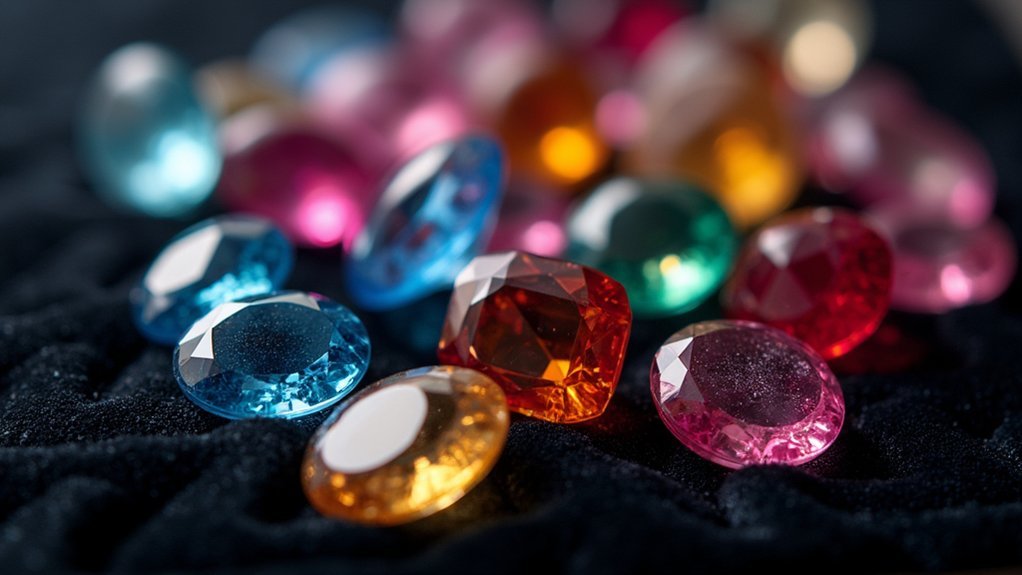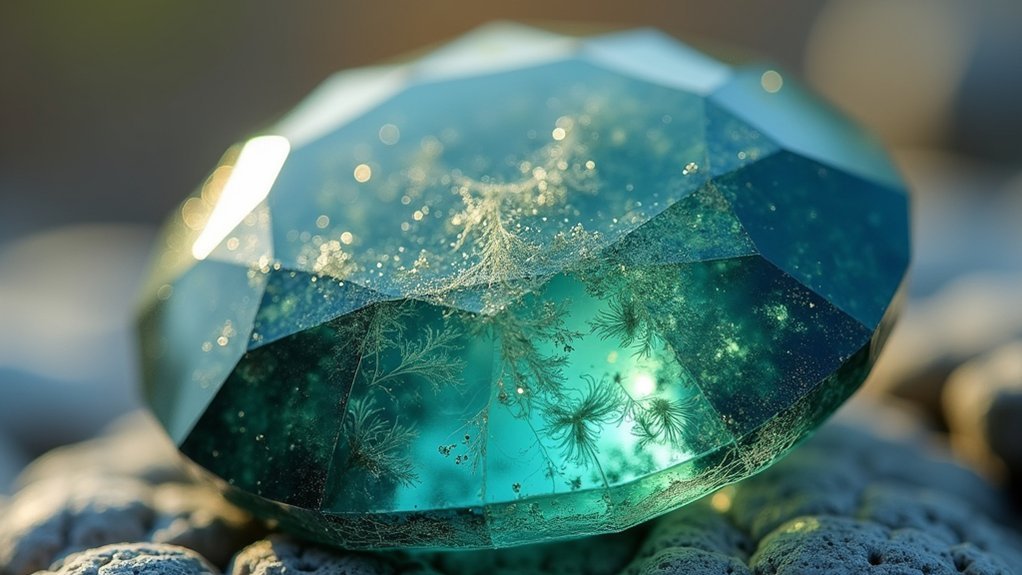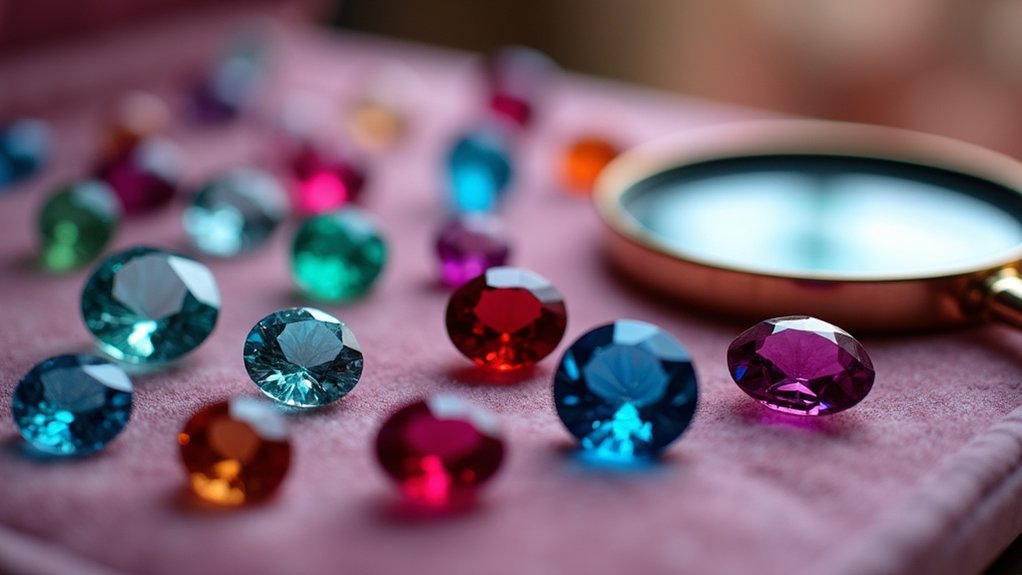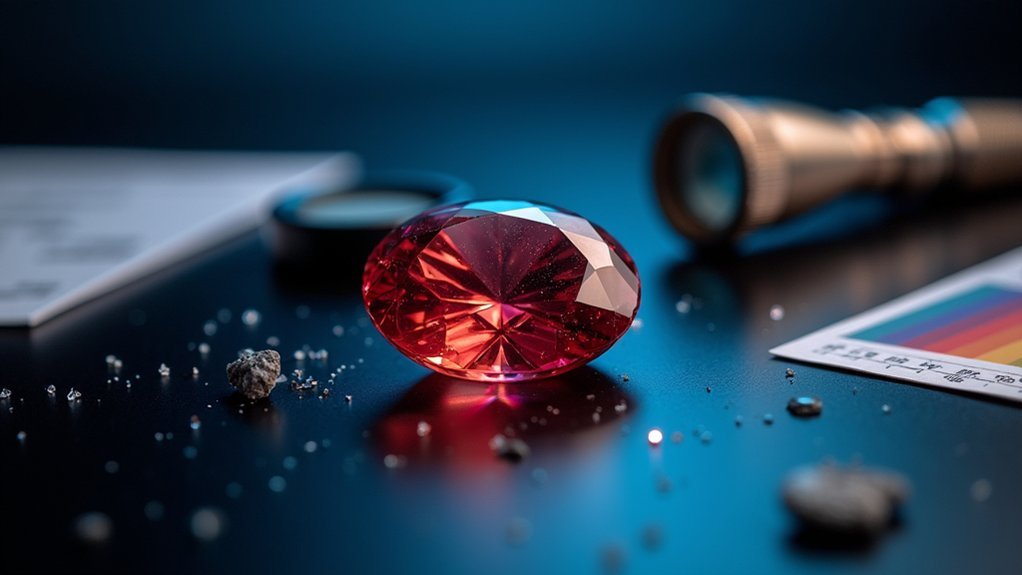You’ll achieve accurate gemstone grading by mastering the Four C’s: color, clarity, cut, and carat weight. Use proper lighting and 10x magnification tools to examine stones under natural daylight or full-spectrum lighting. Understand how internal inclusions like cavities impact value, while eye-clean stones command premium prices. Evaluate color components including hue, tone, and saturation systematically. Compare similar stones side-by-side to assess cut quality and symmetry differences. These professional techniques will reveal deeper insights into gemstone valuation.
Master the Four C’s: Color, Clarity, Cut, and Carat Weight

Four fundamental criteria determine a gemstone’s quality and value: color, clarity, cut, and carat weight.
When grading color, you’ll assess hue, tone, and saturation—higher saturation with medium to medium-dark tones increases overall value.
For clarity evaluation, examine inclusions under 10x magnification; eye-clean stones command premium prices, though some gems like emeralds naturally contain visible inclusions.
Cut directly impacts light performance and brilliance, so you’ll want well-proportioned facets that maximize color presentation.
Carat weight influences pricing considerably, especially at key thresholds like one carat.
Master gemstone quality assessment by balancing these four factors according to your preferences and budget.
Master gemstone assessment by weighing color, clarity, cut, and carat weight against your personal preferences and available budget.
Understanding how each element contributes to grading guarantees you’ll make informed decisions when evaluating precious stones.
Use Proper Lighting and Magnification Tools for Accurate Assessment
Understanding the Four C’s provides the foundation for gemstone evaluation, but your assessment accuracy depends heavily on using proper lighting and magnification tools.
When you assess a gemstone’s color, use natural daylight or full-spectrum lighting to avoid artificial hues that distort true coloration. A 10x magnification loupe enables precise clarity grading by revealing inclusions and blemishes invisible to the naked eye.
Position stones at eye level rather than under overhead lighting to eliminate glare that obscures critical features.
To evaluate gemstone cut quality, examine the stone from multiple angles under magnification, checking for symmetrical proportions and polish quality.
Proper lighting and magnification tools enhance visibility of subtle color variations and internal characteristics that greatly impact gemstone grading accuracy and overall value determination.
Understand Inclusion Types and Their Impact on Gem Value

While proper lighting and magnification reveal a gemstone’s surface characteristics, they’re equally essential for identifying inclusions that profoundly affect value.
These internal flaws include cavities, fingerprints, and color zoning that directly impact gemstone value through clarity grades.
Understanding how inclusions influence market value requires evaluating:
Accurate inclusion assessment demands systematic evaluation of size, quantity, positioning, and type to determine true market impact.
- Size and visibility – Eye-clean stones command premium prices, while visible inclusions considerably reduce worth.
- Number and location – Multiple or centrally-positioned inclusions lower grading assessments more drastically.
- Type characteristics – Some inclusions like silk in sapphires can enhance brilliance and increase value.
- Market preferences – Higher clarity grades consistently achieve better market positioning.
Your grading accuracy depends on recognizing that while most inclusions decrease value, certain types can be desirable.
Focus on determining whether stones achieve eye-clean status, as this distinction significantly affects their market value and overall desirability.
Evaluate Color Components: Hue, Tone, and Saturation
Color evaluation forms the foundation of gemstone grading, requiring you to assess three distinct components that work together to determine a stone’s beauty and market value.
First, examine hue—the basic gemstone’s color including primary and secondary elements. You’ll want to identify pure hues, as they’re most valuable in gemstone grading.
Next, evaluate tone, which measures lightness or darkness. Medium-dark tones typically command premium prices because they showcase ideal color depth without appearing too light or overly dark.
Finally, assess saturation—the intensity and purity of color. Higher saturation creates more vibrant, desirable stones that greatly boost overall appeal and value.
Remember that diamonds follow a different color grading system, ranging from D (colorless) to Z (light yellow/brown), where colorlessness increases value.
Compare Similar Stones to Assess Cut Quality and Symmetry

When evaluating gemstones side by side, you’ll quickly notice how cut quality separates exceptional stones from mediocre ones.
Comparing similar stones under identical lighting reveals significant differences in symmetry, brilliance, and visual appeal that impact overall value.
Side-by-side evaluation under consistent lighting conditions exposes dramatic variations in cut quality that directly determine a gemstone’s worth and desirability.
Use these assessment techniques:
- Examine facet symmetry – Well-aligned facets create superior light performance, while asymmetrical cuts diminish sparkle and reduce the gemstone’s hue intensity.
- Measure proportions with a loupe – Check for ideal table size relative to overall dimensions, as precise measurements optimize light entry and reflection.
- Evaluate polish quality – Well-polished surfaces exhibit exceptional shine and clarity compared to stones with visible scratches or dullness.
- Compare color presentation – Expert cuts showcase vibrant hues more effectively, enhancing the stone’s natural beauty and market appeal.
Frequently Asked Questions
What Are the 4 C’s of Gemstone Grading?
You’ll evaluate gemstones using the four C’s: Cut, which affects brilliance; Clarity, measuring inclusions; Color, describing hue and saturation; and Carat Weight, determining size. These factors collectively establish your gemstone’s quality and value.
How to Tell if a Gemstone Is High Quality?
You’ll identify high-quality gemstones by checking for vibrant, pure colors with excellent saturation, eye-clean clarity without visible inclusions, precise cuts with proper proportions, and appropriate carat weight for rarity.
What Are the Three Factors That Are Considered When Determining a Gem’s Value?
You’ll evaluate three primary factors when determining a gem’s value: color, clarity, and cut. These “three C’s” assess the stone’s hue and saturation, internal flaws, and how well it’s been shaped and polished.
What Is the Best Tool to Test Gemstones?
You’ll find a gem tester or refractometer is the best single tool for gemstone testing. It measures refractive index, helping you distinguish between different stone types and identify authenticity accurately.
In Summary
You’ve now got the essential tools for accurate gemstone grading. Remember, you’ll develop expertise through consistent practice and careful observation. Don’t rush your assessments—take time to examine each stone thoroughly under proper lighting. Keep comparing similar gems to sharpen your eye for quality differences. With these five techniques, you’ll confidently evaluate gemstones and make informed decisions whether you’re buying, selling, or simply appreciating these natural treasures.





Leave a Reply